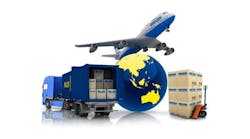From Amazon to Alibaba, Uber freight to drone delivery, logistics technology has seen its fair amount of action in 2017, Freightos, the online marketplace for freight, has just released their 2017 Q2 LogTech Report, providing unique and valuable insights into how exactly these developments are impacting the industry.
Industry Trends
The underlying theme of ocean freight pricing in this quarter was stability, as opposed to the volatility that characterized ocean freight in 2016. According to the Freightos International Freight Index, the standard deviation for China – US (West Coast) prices between March and May 2017 was $69 (5% of the average price), compared to $450, or 30% of the average price, in Q2 2016.
Insufficient demand continues to constrain upward rate mobility, as demonstrated by the negligible pricing impact of the combined effect of Memorial Day, Dragon Boat day and congestion in Shanghai.
Following weak 2016 pricing and lower shipping volumes, logistics spend as a percentage of the US GDP dropped from 7.84% in 2015 to 7.5% in 2016. Meanwhile, US import changes from the expanded Panama Canal will gradually shift some 10% of West Coast imports to the East Coast.
Logistics Technology Trends
During the second half of June, Amazon and Alibaba both held conferences in the United States, appealing to small and midsize businesses selling on their platform. While Alibaba was advocating sales to China as Amazon advocated cross-border importing, both are clearly pursuing an SMB focus, as Big Box retailers continue to struggle.
For enterprise forwarders and carriers, the marching orders for Q2 appeared to be freight visibility, as a number of companies unveiled solutions to enhance cross-supply chain visibility of shipments. The last-mile drone delivery space stayed hot, both in the air and on the ground. Meanwhile, Uber Freight formally launched its product, while continuing to face strong competition from other on-demand trucking startups.
The quarter ended on a somber note for digitization, as a global cyber attack called Petya infiltrated Maersk Line’s systems, leading to a freeze on new bookings of containers on Maersk ships and halting operations at APM terminals for a couple of days.
LogTech Industry Activity
Amazon
Amazon will dominate over half the US e-commerce market by 2021, scaling up from its 34% current market share. It’s next challenge will be to export that success, expanding its 6.6% share of import sales in China by investing in US export infrastructure to service the expanding Chinese middle-class. Amazon is also expanding its private labels offerings, while signs of Amazon-controlled manufacturing draws near, like a recent patent for on-demand clothing manufacturing.
Within the last mile delivery space, Amazon is looking to onboard an army of 10,000 independent couriers for same-day delivery in Japan, side-stepping local courier companies. According to the WSJ, while Amazon has formed a task force in its supply chain division to identify how driverless vehicles can be used to improve the business, it has no plans for internal development of capabilities.
According to industry experts, despite the acquisition of Whole Foods, Amazon still lacks the refrigerated equivalent of the nationwide domestic warehouse space it needs to dominate the grocery space. Within the US, DHL announced it will begin to offer its services to Amazon at its CVG air hub.
Alibaba
Jack Ma is getting more vocal about plans to encourage global businesses to sell to the Chinese market, and, by extension, the global market.
Best Logistics, an Alibaba-backed logistics company, is currently planning a $1 billion dollar IPO in New York in hopes of riding the wave of interest in the Chinese logistics industry, which currently accounts for 25% of the $9 trillion annual global logistics industry.
Not to be beat out in last mile, over the next decade, Cainiao Network plans to deploy one million smart vehicles, augmented by artificial intelligence, to reduce time and distance travelled for their courier delivery network in China. 5
Logistics
Evergreen Line joined other carriers offering services through the Alibaba platform. Meanwhile, CMA CGM announced investments in five startups while offering online Asia-Europe bookings through AgreeFreight.
Q2 was a strong quarter for visibility technology. DHL Global Forwarding launched both Ocean View, which offers real-time updates on maritime shipments, DHL SupplyWatch, an AI program for identifying supply chain disruptions, and Saloodo, an online trucking marketplace. DP World also released a container visibility solution in the UK, as French startup Traxens unveiled a smart freight train tracking solution. In Germany, Panalpina launched a pilot ocean shipment management system. Finally, CHAMP took tracking further with voice-based air cargo tracking via Alexa .
Undaunted by a hack that snarled global operations, Maersk continues multiple digital initiatives, including a partnership with Chinese ecommerce platform Yun Qu Na, an Alibaba partnership, collaboration with IBM on block-chain, rollout of Microsoft’s Azure platform and more. Maersk also accepted the delivery of the world’s largest box ship this quarter, clocking in at 20,179 TEUs. Perhaps most telling of the digital sales ecosystem, Damco, Maersk’s freight forwarder, launched Twill Logistics, a digital forwarder that offers online quoting, shipment management, exception management and document handling.
In the startup space, Freightos extended service for its online Freight Marketplace to the UK, as Haven, until recently a marketplace for bulk shipping, pivoted to focus on providing a TMS for shipment management. Shipamax, a freight shipping communication startup, raised $2.5 million dollars.
Samsung SDS is spearheading a Korean blockchain consortium to streamline collaboration with across the supply chain ecosystem.
New Silk Road services continue to emerge, ranging from a weekly China-Italy freight service to ongoing service from Ziamen port to Moscow. Alibaba is also acquiring warehouses along the Silk Road, while WACO System expanded its network to three members along the route. 6
Trucking
After beginning the quarter by revealing first images of a tunneling machine from The Boring Company, a startup Elon Musk believes can create to a network of multi-layered underground tunnels for alleviating traffic, Musk closed the quarter by tweeting that the first elevator for lowering cars into the tunnels was ready.
According to some industry observers, Uber’s entrance into the freight trucking may have been off to a bumpy start, facing competition from a fairly saturated tech environment, all while engaged in a legal battle with Google’s Waymo (which revealed its own autonomous truck). This provides valuable lead time for competitors, like Ontruck, a Spanish startup that raised a $10 million round to vie for market share in the space.
The US trucking market continues to evolve into being more customer-oriented and technology-based. Justin Hall, the Chief Customer Officer at YRC, described YRC as “a technology company with an LTL network”, helping customers compensate for shrinking logistics departments. Riding the technology bandwagon, competitor J.B. Hunt revealed an online trucking marketplace for carrier booking.
KeepTruckin, a startup that assists truck logging with both software and hardware, has raised $18 million dollars. Finally, Peloton Technology raised $60 million from investors (including Intel, which recently closed a massive $15 billion purchase of autonomous vehicle company Mobileye), to develop convoy technology that should see commercial usage before the end of the year.
Last Mile Delivery
Darkstore, a fulfillment startup that helps companies provide same-day delivery, raised $1.4 million in funding.
Shipbob raised an additional $17.5 million to compete with Fulfilled By Amazon (FBA) for warehousing and last-mile fulfillment.
Shippit, an Australian fulfillment company, raised $1.6 million dollars to scale order fulfillment and tracking for retailers.
Indian Loadshare raised an undisclosed amount of funding for its remote delivery SaaS marketplace platform. The company currently handles over 10,000 shipments per day 7
Drones
Robotics warehouse startup Locus Robotics, formed by former employees after Amazon’s acquisition of KIVA, unveiled faster autonomous warehouse operations with robot-to-robot communication. The company’s robots are used by major retailers and forwarders like DHL Supply Chain. Hot on the track for more automated warehouse operations, RightHand Robotics is developing robots that can pick and pack boxes.
JD.com, the second-largest Chinese e-commerce platform, is investing heavily in a newly-created logistics unit to optimize warehousing, transportation and delivery
Safety issues continue to plague aerial drones. The UK reported three narrow misses between drones and airplanes near Heathrow during a three-week period last year, while registering 70 misses throughout 2016, up from 29 in 2015. The FAA recently barred drones from flying within 400 feet of 133 US military bases.
Hermes will pilot parcel collection with a Starship Technologies ground drones in Southwark, London, as Boston Dynamics tests a dog-shaped delivery robot. For longer deliveries, Teleretail AG revealed a ground delivery solution with a 50-mile range.
Natilus’ jet-sized drone will carry up to 200,000 pounds in cargo on international shipments, traveling at slower and more affordable speed than air freighters. Mitsui OSK Lines (MOL) was chosen by the Japanese government to explore the technology and infrastructure changes required for autonomous ocean shipping. Japan is currently on track to enable drone deliveries by 2020, followed by self-driving trucks by 2022.
Google’s Project Wing completed a number of drone traffic control tests set by the FAA and NASA to help manage air traffic control.



